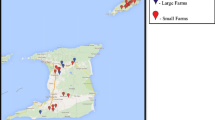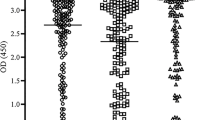Abstract
Pseudorabies (PR) has been prevalent in Chinese swine breeding farms since the outbreak at the end of 2011. For investigating current prevalence of PR, a nationwide surveillance has been performed in this study. The swine serum samples were collected from 93, 100, 92, and 91 swine farms in China during 2013–2016, respectively. Since the extensive use of gE-deleted pseudorabies virus (PRV) vaccine, we could apply the PRV-gE antibody for determining wild-type virus infection and the PRV-gB antibody for evaluating vaccine immunization. The results were concluded as follows: (1) Nationally, the positive rate of PRV-gB was maintained at a high level (> 90%), while the positive rate of PRV-gE continued to decrease (from 22.17 to 13.14%). (2) The positive rates of PRV-gE were greatly varied in different geographical regions and swine farms (0~100%), while the positive rate of PRV-gB was generally high (> 90%). (3) The number of imported PRV attenuated vaccines were about twice that of domestic PRV attenuated vaccines, while the positive rate of PRV-gB was not significantly different (P > 0.05). (4) The performance of PR eradication developing or developed farms was better than the performance of common farms, with higher positive rate of PRV-gB (> 90%) and much lower positive rate of PRV-gE (nearly 0%).



Similar content being viewed by others
References
An, T.Q., Peng, J.M., Tian, Z.J., Zhao, H.Y., Li, N., Liu, Y.M., Chen, J.Z., Leng, C.L., Sun, Y., Chang, D., Tong, G.Z., 2012. Pseudorabies virus variant in bartha-k61–vaccinated pigs, china, 2012. Emerging Infectious Diseases, 19, 1749–1755.
Beran, G.W., 1993. Understanding the transmission of PRV. Veterinary Medicine. 88, 70–79.
Dong, J., Bai, J., Sun, T., Gu, Z., Wang, J., Sun, H., Jiang, P., 2017. Comparative pathogenicity and immunogenicity of triple and double gene-deletion pseudorabies virus vaccine candidates. Research in Veterinary Science, 115, 17–23.
Freuling, C.M., Müller, T.F., Mettenleiter, T.C., 2017. Vaccines against pseudorabies virus (PrV). Veterinary Microbiology, https://doi.org/10.1016/j.vetmic.2016.11.019.
Hu, D., Lv, L., Zhang, Z., Xiao, Y., Liu, S., 2015, Seroprevalence and associated risk factors of pseudorabies in Shandong province of China. Journal of Veterinary Science, 17, 361–368.
Mettenleiter, T.C., 2000. Aujeszky’s disease (pseudorabies) virus: the virus and molecular pathogenesis-state of the art, June 1999. Veterinary research, 31, 99–115.
Müller, T., Bätza, H.J., Schlüter, H., Conraths, F.J., Mettenleiter, T.C., 2003. Eradication of aujeszky’s disease in Germany. Journal of Veterinary Medicine B Infectious Diseases & Veterinary Public Health, 50, 207–13.
Pomeranz, L.E., Reynolds, A.E., Hengartner, C.J., 2005. Molecular biology of pseudorabies virus: impact on neurovirology and veterinary medicine. Microbiology and molecular biology reviews, 69, 462–500.
Stegeman, A., 1997. Aujeszky’s disease (pseudorabies) virus eradication campaign in the Netherlands. Veterinary Microbiology, 55, 175–180.
Tong, W., Li, G., Liang, C., Liu, F., Tian, Q., Cao, Y., Li, L., Zheng, X., Zheng, H., Tong, G., 2016. A live, attenuated pseudorabies virus strain JS-2012 deleted for gE/gI protects against both classical and emerging strains. Antiviral research, 130, 110–117.
Vannier, P., Vedeau, F., Allemeersch, C., 2000. Eradication and control programmes against Aujeszky’s disease (pseudorabies) in France. Veterinary Microbiology, 15, 519–536.
Wu, R., Bai, C.Y., Sun, J.Z., Chang, S.K., Zhang, X., 2013, Emergence of virulent pseudorabies virus infection in Northern China. Journal of veterinary science, 14, 363–365.
Yu, X., Zhou, Z., Hu, D., Zhang, Q., Han, T., Li, X., Gu, X., Yuan, L., Zhang, S., Wang, B., Qu, P., Liu, J., Zhai, X., Tian, K., 2014. Pathogenic pseudorabies virus, China,2012. Emerging infectious diseases, 20, 102–104.
Yuan, S., Luo, Y., Wang, C.H., Yuan, J., Li, N., Song, K, Qiu, H. J., 2016, Control of swine pseudorabies in China: Opportunities and limitations. Veterinary Microbiology, 183, 119–124.
Acknowledgements
The authors thank for the financial support from Beijing Agriculture Innovation Consortium (BAIC-02).
Author information
Authors and Affiliations
Corresponding authors
Ethics declarations
The sampling process was in line with animal welfare requirements.
Conflict of interest statement
The authors declare that they have no conflict of interest.
Rights and permissions
About this article
Cite this article
Liu, Y., Zhang, S., Xu, Q. et al. Investigation on pseudorabies prevalence in Chinese swine breeding farms in 2013–2016. Trop Anim Health Prod 50, 1279–1285 (2018). https://doi.org/10.1007/s11250-018-1555-1
Received:
Accepted:
Published:
Issue Date:
DOI: https://doi.org/10.1007/s11250-018-1555-1




